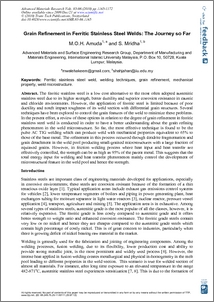Amuda, M.O.H. and Mridha, Shahjahan
(2010)
Grain refinement in ferritic stainless steel welds: The journey so far.
Advanced Materials Research, 83-86.
pp. 1165-1172.
ISSN 1022-6680
![[img]](http://irep.iium.edu.my/style/images/fileicons/application_pdf.png)  Preview |
|
PDF (Grain refinement in ferritic stainless steel welds: the journey so far)
- Published Version
Download (1MB)
| Preview
|
Abstract
The ferritic stainless steel is a low cost alternative to the most often adopted austenitic stainless steel due to its higher strength, better ductility and superior corrosion resistance in caustic and chloride environments. However, the application of ferritic steel is limited because of poor ductility and notch impact toughness of its weld section with differential grain structures. Several
techniques have been explored to control the grain features of the weld to minimize these problems. In the present effort, a review of these options in relation to the degree of grain refinement in ferritic stainless steel weld is conducted in order to have a better understanding about the grain refining phenomenon in the weld microstructure. So far, the most effective technique is found to be the
pulse AC TIG welding which can produce weld with mechanical properties equivalent to 65% to those of the base metal. The refinement in this process occurred through dendrite fragmentation and grain detachment in the weld pool producing small-grained microstructures with a large fraction of equiaxed grains. However, in friction welding process where heat input and heat transfer are effectively controlled, the strength can be as high as 95% of the parent metal. This suggests that the total energy input for welding and heat transfer phenomenon mainly control the development of microstructural feature in the weld pool and hence the strength.
Actions (login required)
 |
View Item |


 Download Statistics
Download Statistics Download Statistics
Download Statistics